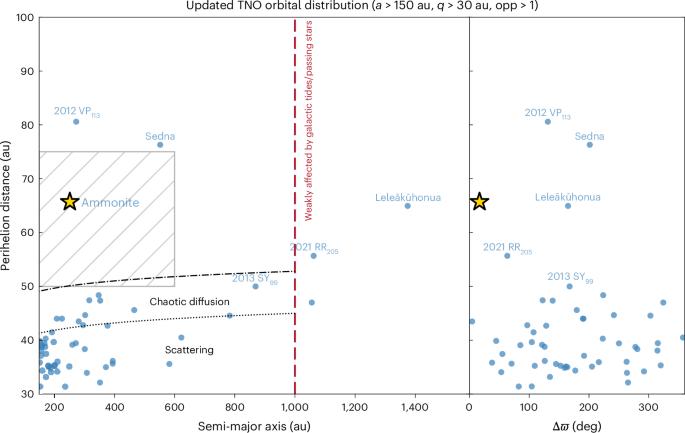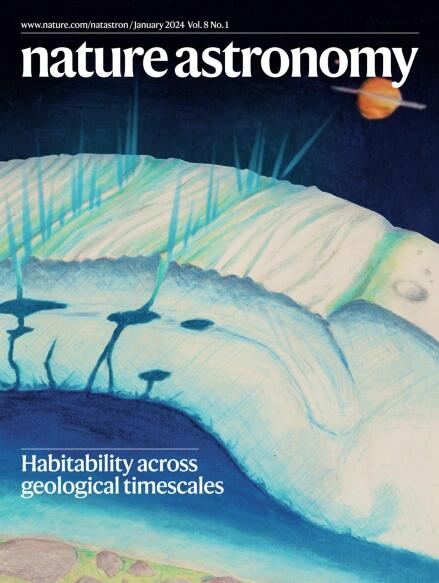Discovery and dynamics of a Sedna-like object with a perihelion of 66 au
IF 14.3
1区 物理与天体物理
Q1 ASTRONOMY & ASTROPHYSICS
引用次数: 0
Abstract
Trans-Neptunian objects (TNOs) with large perihelion distances (q > 60 au) and semi-major axes (a > 200 au) provide insights into the early evolution of the Solar System and the existence of a hypothetical distant planet. These objects are challenging to observe, and thus their detections are still rare, yet they play a crucial role in constraining models of Solar System formation. Here we report the discovery of a Sedna-like TNO, 2023 KQ14, nicknamed ‘Ammonite’, with q = 66 au, a = 252 au and inclination i = 11°. The orbit of Ammonite does not align with those of the other Sedna-like objects and fills the previously unexplained ‘q-gap’ in the observed distribution of distant Solar System objects. Simulations demonstrate that Ammonite is dynamically stable over 4.5 Gyr. Our analysis suggests that Ammonite and the other Sedna-like objects may have shared a primordial orbital clustering around 4.2 Ga. Furthermore, the stable orbit of Ammonite favours larger orbits (~500 au) rather than closer ones for a large hypothetical planet in present-day trans-Neptunian space. The discovery of 2023 KQ14, a Sedna-like object with a perihelion of 66 au, fills a gap in the known population. Its orbit does not align with other Sedna-like objects, shedding light on the diversity and dynamical history of the outer Solar System.


发现一颗近日点为66天文单位的类塞德娜天体及其动力学
具有大近日点距离(60天文单位)和半长轴(200天文单位)的海王星外天体(TNOs)提供了对太阳系早期演化和假设的遥远行星存在的见解。这些天体的观测具有挑战性,因此它们的探测仍然很少,但它们在约束太阳系形成模型中发挥着至关重要的作用。在这里,我们报告发现了一颗类似塞德娜的TNO, 2023 KQ14,绰号“鹦鹉螺”,q = 66 au, a = 252 au,倾角i = 11°。“鹦鹉螺”的轨道与其他类似塞德娜的天体并不一致,它填补了之前观测到的遥远太阳系天体分布中无法解释的“q缺口”。模拟结果表明,菊石在4.5 Gyr范围内是动态稳定的。我们的分析表明,菊石和其他类似塞德纳的物体可能在4.2 Ga左右共享一个原始轨道群。此外,鹦鹉螺的稳定轨道更倾向于更大的轨道(~500 au),而不是更近的轨道,因为在今天的海王星外空间中,它是一颗假设的大型行星。
本文章由计算机程序翻译,如有差异,请以英文原文为准。
求助全文
约1分钟内获得全文
求助全文
来源期刊

Nature Astronomy
Physics and Astronomy-Astronomy and Astrophysics
CiteScore
19.50
自引率
2.80%
发文量
252
期刊介绍:
Nature Astronomy, the oldest science, has played a significant role in the history of Nature. Throughout the years, pioneering discoveries such as the first quasar, exoplanet, and understanding of spiral nebulae have been reported in the journal. With the introduction of Nature Astronomy, the field now receives expanded coverage, welcoming research in astronomy, astrophysics, and planetary science. The primary objective is to encourage closer collaboration among researchers in these related areas.
Similar to other journals under the Nature brand, Nature Astronomy boasts a devoted team of professional editors, ensuring fairness and rigorous peer-review processes. The journal maintains high standards in copy-editing and production, ensuring timely publication and editorial independence.
In addition to original research, Nature Astronomy publishes a wide range of content, including Comments, Reviews, News and Views, Features, and Correspondence. This diverse collection covers various disciplines within astronomy and includes contributions from a diverse range of voices.
 求助内容:
求助内容: 应助结果提醒方式:
应助结果提醒方式:


